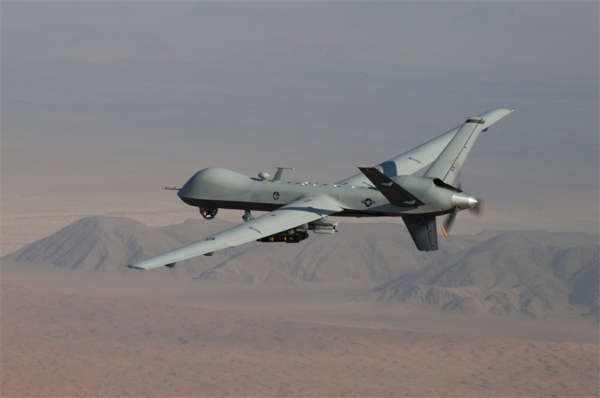Army Unmanned Aerial Vehicle (UAV) Operators (MOS 15W) work as remote pilots of unmanned observation aircraft, otherwise known as drones.
UAVs are used to gather intelligence so MOS 15Ws are considered intelligence specialists.
Army UAV Operators (MOS 15W) are an important part of the U.S. Armed Forces, as they collect information regarding enemy forces and battle areas.
Related Article – Army MOS List: A List Of All 159 Army Jobs
Education, Qualifications, Training, and Duty Stations
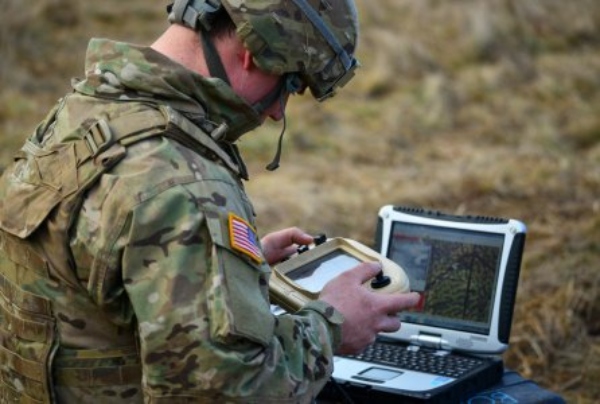
Unmanned Aerial Vehicles (or UAVs) are the military term for drones.
As an MOS 15W, you will learn how to operate these unmanned aerial vehicles in order to collect intelligence.
Army UAV Operators (MOS 15W) are very important because they are deemed safer than risking human lives in order to gather information.
Education
Are you interested in joining the U.S. Army?
There are a number of qualifications you need to have, including having a high school diploma or GED equivalent.
Furthermore, you must complete the Armed Services Vocational Aptitude Battery (ASVAB) at the nearest MEPS station.
Those who are interested in becoming Army UAV Operators (MOS 15W) must score Surveillance & Communications (SC): 102.
Qualifications
There are a number of qualifications required to become an Army UAV Operator (MOS 15W).
First, you need to demonstrate normal color vision.
Secondly, you must not have a record of conviction by a civil court for any offense other than minor traffic violations.
The same is true of the military, as there must be no conviction by court-martial.
Additionally, you must gain a security clearance of “Secret.”
The Army uses an extensive background check in order to determine if there are any risks to providing you with a military security clearance.
It is also helpful to have an interest in remote/radio control vehicles, like drones.
The Army also mentions 15W MOS are generally able to show attention to detail, think and write clearly, as well as organize information and study its meaning.
Training
Army recruits begin their training at boot camp. Boot camp — or Basic Combat Training — is 10 weeks for all new recruits.
If you survive boot camp, you’ll progress to Advanced Individual Training.
AIT is intense for an Army UAV Operator. It lasts over 23 weeks, which is double or more time compared to many other Army Military Occupation Specialties (MOS).
Advanced Individual Training consists of in-the-field training and classroom learning.
You will learn:
- How to perform intelligence, surveillance, and reconnaissance simulation missions.
- How to prepare maps, charts, and intelligence reports.
- The methods for analyzing aerial photographs.
- How to use various computer systems.
Duty Stations
Those serving in the Army in MOS 15W can expect to be potentially based at one of the following duty stations:
Inside the Continental US (CONUS)
- Camp Mackall, NC
- Eglin AFB, FL
- Fort Bliss, TX
- Fort Campbell, KY
- Fort Carson, CO
- Fort Cavazos, TX
- Fort Drum, NY
- Fort Huachuca, AZ
- Fort Hunter Liggett, CA
- Fort Irwin, CA
- Fort Johnson, LA
- Fort Liberty, NC
- Fort Moore, GA
- Fort Riley, KS
- Fort Stewart, GA
- Joint Base Lewis-McChord, WA
Outside the Continental US (OCONUS)
- Fort Wainwright, AK
- Joint Base Elmendorf-Richardson, AK
- USAG Bavaria, Germany
- USAG Hawaii
- USAG Italy, Vicenza
- USAG Yongsan-Casey, South Korea
What does an Army Unmanned Aerial Vehicle (UAV) Operator Do?
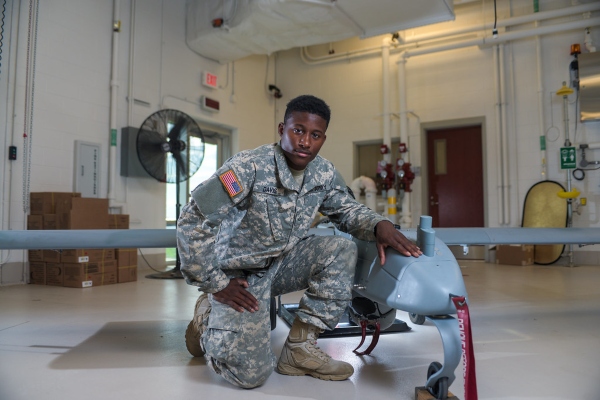
Army UAV Operators work as remote pilots of unmanned observation aircraft vehicles.
The main purpose of unmanned aerial vehicles (UAVs) is to collect intelligence needed for operational tactics.
Related Article – US Army Grooming Standards
Operating Unmanned Aerial Vehicles (UAV)
Those in 15W MOS serve primarily in reconnaissance missions that were previously carried out by human soldiers but are slowly being phased out by drones.
Drones, or unmanned aerial vehicles (UAV), are considered much safer without posing a danger of losing human life.
As a result, you will learn how to operate UAVs for air reconnaissance, surveillance, targeting, and acquisition missions.
Flight Planning
Since you are a remote pilot, you need to know not only how to operate a UAV, but also how to plan and analyze flight missions.
As a result, you will learn aerodynamics and become an expert at the remote piloting of drones in MOS 15W.
You will also perform pre-flight, in-flight, and post-flight checks and procedures.
Army UAV Operators must also launch and recover airframes from the runway.
Maintenance & Repairs
As an Army UAV Operator (MOS 15W), you will spend downtime performing maintenance on your drone.
Additionally, you will maintain communications equipment, power sources, light/heavy-wheeled vehicles, and crane operations.
Depending on your Army rank, you may supervise or assist in a variety of repairs.
What does an Army Unmanned Aerial Vehicle (UAV) Operator make?
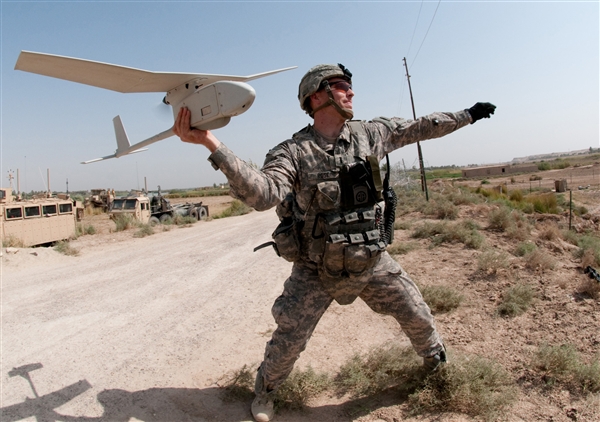
There is no pay chart directly related to serving in the U.S. Army as a UAV Operator (MOS 15W).
MOS 15W is like other Military Occupation Specialties, in that your salary is determined based on your rank and years of service.
Basically, the longer you serve and the higher your Army rank, the more you can expect to earn:
| Insignia | Pay Grade | Rank | Abbreviation | Minimum Monthly Pay |
|---|---|---|---|---|
| E-1 +4 months | Private | PVT | $1,917.60 | |
| E-2 | Private Second Class | PV2 | $2,149.20 | |
| E-3 | Private First Class | PFC | $2,259.90 | |
| E-4 | Specialist | SPC | $2,503.50 | |
| E-4 | Corporal | CPL | $2,503.50 | |
| E-5 | Sergeant | SGT | $2,730.30 | |
| E-6 | Staff Sergeant | SSG | $2,980.50 | |
| E-7 | Sergeant First Class | SFC | $3,445.80 | |
| E-8 | Master Sergeant | MSG | $4,957.20 | |
| E-8 | First Sergeant | 1SG | $4,957.20 | |
| E-9 | Sergeant Major | SGM | $6,055.50 | |
| E-9 | Command Sergeant Major | CSM | $6,055.50 | |
| E-9 | Sergeant Major of the Army | SMA | $6,055.50 |
Benefits
The U.S. Army has several benefits that go along with your monthly salary:
- Paid Medical Insurance
- Vacation Time
- Special Pay
- Retirement
- Education: Army members can earn full tuition, merit-based scholarships, allowances for books and fees, plus an annual stipend for living expenses.
- Housing: Allowances for living expenses, utilities, and maintenance.
- Food: Allowance for the on-base dining hall and access to tax-free department and grocery stores.
Related Article: Army Height And Weight Standards
Job Reviews
The role of an Army UAV Operator (MOS 15W) is relatively new to the U.S. Army.
Consequently, the list of job reviews for the MOS is not quite as detailed and extensive as other military careers.
One poster mentioned that it is a fast-paced, yet rewarding work environment:

Another job review did a good job of weighing the pros and cons of the U.S. Army:
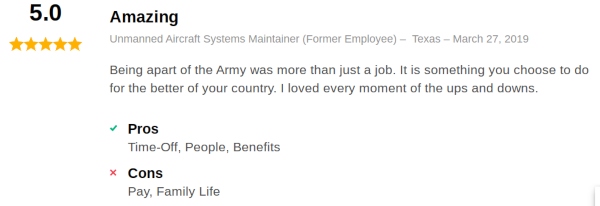
Here is a good example of what you can expect day-to-day serving the Army in MOS 15W:
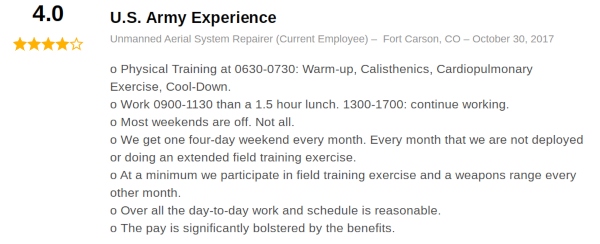
Civilian Job Opportunities
An Army UAV Operator (MOS 15W) is a relatively new position within the U.S. Army.
However, as each year passes, more and more reliance is made on the success of reconnaissance, surveillance, targeting, and acquisition missions.
Civilian jobs are also starting to introduce drones into their daily operations.
As a result, you can continue working for the federal government as either part of the Central Intelligence Agency (CIA) or National Security Agency (NSA) following service in the U.S. Army.
MOS 15W make excellent additions to the CIA and NSA given their piloting skills as trained drone operators.
If you wish to work in the private sector, there are jobs needed for drone operators related to research and business planning.
Summary
Army UAV Operators (MOS 15W) are becoming an increasingly important role in the U.S. Army.
Unmanned aerial vehicles (UAVs) are slowly replacing humans in certain types of missions such as reconnaissance work and surveillance.
You will work remotely gathering intelligence for the U.S. Army and help save lives in the process.
Resources:
- https://www.goarmy.com/careers-and-jobs/browse-career-and-job-categories/transportation-and-aviation/unmanned-aerial-vehicle-operator.html
- https://www.indeed.com/salaries/Unmanned-Aircraft-Systems-Repairer-Salaries-at-U.S.-Army
- Ikon Pass Military Discount: Learn How To Save Big - January 31, 2025
- RTIC Military Discount: Find Out How To Save Big on Gear - January 30, 2025
- Traeger Military Discount: Learn How To Save Big on Smokers - January 28, 2025
General FAQ
What is MOS 15W in the army?
MOS 15W is an Army Unmanned Aerial Vehicle (UAV) Operator (MOS 15W). The MOS 15 series focuses on aviation and aircraft repair and includes helicopter maintenance, aircraft electricians, air traffic controllers, and UAV operators.
How long is AIT for MOS 15W?
Advanced Individual Training (AIT) to become an Army Unmanned Aerial Vehicle (UAV) Operator (MOS 15W) is pretty intensive, taking 23 weeks or more after graduation from Basic Combat Training (BCT).
Does the army have drones?
Army Unmanned Aerial Vehicle (UAV) Operators, or drone pilots, use them to provide intelligence in support of military operations because they can remain airborne for 24 hours or more. The Army uses them when manned flight is considered too risky.
How much does a drone pilot make in the army?
Like other Army personnel, UAV operators (MOS 15W) are paid according to rank and time in service. A new recruit with less than two years in service can currently expect a monthly base pay of $1,917.
How do you become a drone pilot in the Army?
You’ll need to obtain a “Secret” level security clearance to become an Army Unmanned Aerial Vehicle (UAV) Operator. You’ll also need normal color vision and a score of 102 or higher on the Surveillance & Communications section of the ASVAB.

